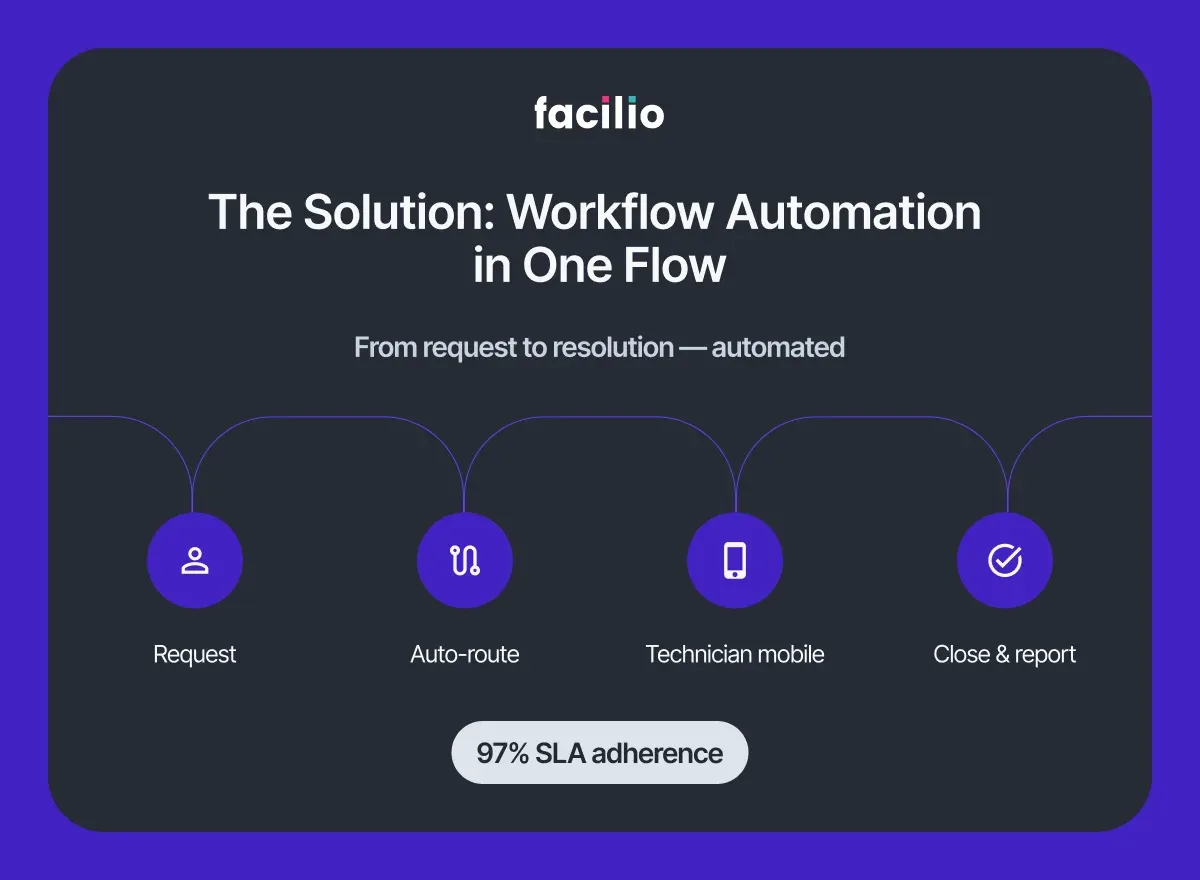Workflow automation: The secret recipe to operational efficiency
Business processes adopt various workflows to ensure tasks are completed and business goals are achieved on time. These workflows, in turn, involve various activities (like sending emails and messages, scheduling meetings, and so on) that might require a great deal of human intervention to keep them moving forward.
The substantial expansion of the global facility management market, valued at USD 1,277.8 billion in 2023 and projected to reach USD 2,284.8 billion by 2032, underscores the growing demand for efficient FM practices across various sectors.
The current state of FM, however, is characterized by disjointed processes, manual interventions, and communication gaps. Inefficiencies that lead to delayed responses, increased costs, and decreased tenant satisfaction.
Standing out in such a competitive and crowded environment with tech that traps you in an endless fire-fighting spells disaster for growth-both, for organizations and professionals.
The current challenge: A disconnected ecosystem
Typically, today, facility managers work with a system of records. This means that ‘information’ is stored and passed on between people through a multitude of tools. For instance, teams use emails to communicate, spreadsheets to update status, phone calls/chat to clarify, etc.
Service requests often languish in overflowing email inboxes, maintenance tasks are tracked on scattered spreadsheets, and vendors struggle to access crucial information. This fragmented approach results in a reactive, rather than proactive, management style.
In addition to this, they also make investments in additional software or build their own. Analytics and dashboard software are great examples of this.
So, every workflow goes through a range of tools - both digital and otherwise - becoming inefficient, unintelligent and tedious at each consecutive step.
To say nothing of the fact that they eat into the operating margins.
For example, a simple task like addressing a tenant's HVAC complaint can turn into a logistical nightmare.
The complaint might be buried in an email thread, the assigned technician might be unaware of the issue's urgency, and the tenant might be left in the dark about the resolution timeline.
This lack of transparency and coordination breeds frustration and erodes trust.
To overcome this and move from a ‘system of record’ to a ‘system of action’, enterprises need workflow automation.
This means that BAS systems, working alone at store levels, may not be enough. We need to rethink how portfolio operations are managed.
Rajvel, the co-founder and CPO, dives deeper into this perspective here - Building automation needs innovation big time (and it’s all coming together finally)
Why workflow automation is non-negotiable for FMs
The urgency to modernize operations is undeniable in an industry where reputation is paramount. The challenges faced by FMs are clear and pressing:
- Resource Constraints: Limited manpower and budget often hinder FMs' ability to tackle the growing complexity of their responsibilities.
- Data Silos: Disparate systems and manual data entry create information silos, making it difficult to gain actionable insights and make informed decisions.
- Reactive Maintenance: Without proactive systems, FMs are often forced into reactive maintenance, leading to higher costs and potential disruptions.
- Suboptimal Occupant Experience: Manual processes can slow down response times to tenant requests and create inconsistencies in service delivery.
The cost of inaction is significant. Inefficient operations translate to wasted resources, missed opportunities for cost savings, and a negative impact on tenant satisfaction.
The Solution: Facilio's Connected CMMS

Facilio's Connected CMMS platform acts as a digital nervous system, connecting every stakeholder in the FM ecosystem and orchestrating seamless operations.
Let's revisit the HVAC complaint scenario. With Facilio, the tenant can submit a service request through a user-friendly portal.
Your team can ditch the messy paperwork and endless email chains.
With a few clicks, service requests are automatically routed to the right technician, complete with all the necessary details.
Real-time updates and a bird's-eye view of all ongoing tasks mean you're always in control, without the chaos.
Empowering stakeholders across the board
Facilio's Connected CMMS gives you the customizability and flexibility to tailor your facility management processes to your unique needs, fostering a seamless and efficient workflow that benefits everyone involved.
For a start, each client, team, vendor, and stakeholder you choose has separate access within Facilio. They are neatly arranged within Facilio's Maintenance app, Client, Tenant, and Vendor portals.
Let's dive deeper into how different stakeholders work within Facilio.
1. For your vendors: Streamline communication and collaboration with a centralized platform that provides instant access to work orders, safety protocols, and essential documentation.
This eliminates delays, reduces errors, and fosters a transparent working relationship.
With real-time updates and seamless communication, vendors can efficiently manage their tasks and deliver exceptional service.
2. For your technicians: Empower your technicians with a mobile app that puts all the information they need right at their fingertips. No more searching for lost work orders or deciphering handwritten notes.
With detailed instructions, location maps, and equipment history readily available, technicians can diagnose and resolve issues faster, improving productivity and tenant satisfaction.
They get instant access to everything they need – work orders, safety plans, equipment manuals, work permits, you name it. The mobile experience is made truly seamless because the CMMS pulls data directly from other critical systems, like work permit software and visitor management software.
They can even update their progress in real time, keeping everyone informed and eliminating those frustrating "Where are we on this?" conversations.
3. For your clients and tenants: Your clients and tenants want to feel heard and informed. Provide your clients and tenants with a user-friendly portal to submit service requests, track progress, and provide feedback.
This transparency builds trust and ensures their concerns are addressed promptly. Empowering them to participate in the maintenance process enhances their experience and fosters a positive relationship.
Additionally, it provides valuable insights into what works and what doesn't.
4. For the executives: Facilio enables centralized operational visibility - Take control of your building operations with a centralized property operations solution.
Get a comprehensive view of your portfolio’s O&M score, including maintenance costs, resource usage, compliance scores, and SLAs.
Also, gain detailed insights into budgets vs. expenditures, asset downtime, repair vs. replacement, and multi-site building scores for benchmarking and informed decision-making.
The Facilio Difference
Facilio's Connected CMMS isn't just a software solution; it's a partner in your pursuit of operational excellence.
It's about giving you the tools, the flexibility, and the agility to create a facility management system that works for you, not against you.
- It lets you create custom workflows and automate them to match your exact processes.
- Need to route specific requests to certain technicians? No problem.
- Want to automate approvals for certain tasks? Done.
This flexibility means your team can work smarter, not harder.
Additionally, with real-time updates and automated reporting, you'll always stay informed about your operations.
What can workflow automation do for enterprises?
Connected CMMS is a reimagined property operations and maintenance approach that connects your systems, people, and processes. One that expands the boundaries of CMMS beyond work orders and maintenance to automate processes, enable stakeholder engagement, and drive connected efficiency—all in one place.
If you think your workflows could do a better job at saving you time and work and deliver more value and useful insights for your team, we may be able to help.

